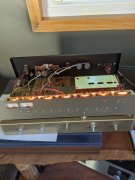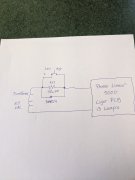Opened it up this morning to check it out. This was a eBay purchase a while back, and it's sat in the closet until now. I plugged it in when I first got it, tuning was wonky, the LEDs for stereo and multipath didn't light in concert with the received signal, nor did the meters. Also had a little bit of play in the string tuning assembly.
The caps and bulbs look all original, and it's very clean inside. First thing I checked was the 19 MHz pilot frequency, was about 400 Hz too high. This seems to be a common issue as there's several posts about this on the internet. Some replace a ceramic cap that's said to have drifted over time causing this. The adjustment pot had enough range to where I could adjust it to 19 MHz spec.
So I plugged it in, per the photo, and now the LEDs and meters work perfectly in sync with the received signal strength,
This is going to be a easy one to recap. Looks like 5 electrolytics and the 1 ceramic for the pilot frequency. The original festoon lamps are no longer available anywhere, but it looks like 6x42mm LED fuse lamps made for McIntosh applications may work. A SMD resistor may or may not need to be increased for the 5000s higher lamp voltage. Easy enough to do if needed.
As it is now, it's a good sounding tuner. Been sitting here listening to a Cleveland OH rock station. Will update.
The caps and bulbs look all original, and it's very clean inside. First thing I checked was the 19 MHz pilot frequency, was about 400 Hz too high. This seems to be a common issue as there's several posts about this on the internet. Some replace a ceramic cap that's said to have drifted over time causing this. The adjustment pot had enough range to where I could adjust it to 19 MHz spec.
So I plugged it in, per the photo, and now the LEDs and meters work perfectly in sync with the received signal strength,
This is going to be a easy one to recap. Looks like 5 electrolytics and the 1 ceramic for the pilot frequency. The original festoon lamps are no longer available anywhere, but it looks like 6x42mm LED fuse lamps made for McIntosh applications may work. A SMD resistor may or may not need to be increased for the 5000s higher lamp voltage. Easy enough to do if needed.
As it is now, it's a good sounding tuner. Been sitting here listening to a Cleveland OH rock station. Will update.
Attachments
-
1.7 MB Views: 30


